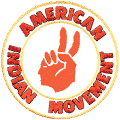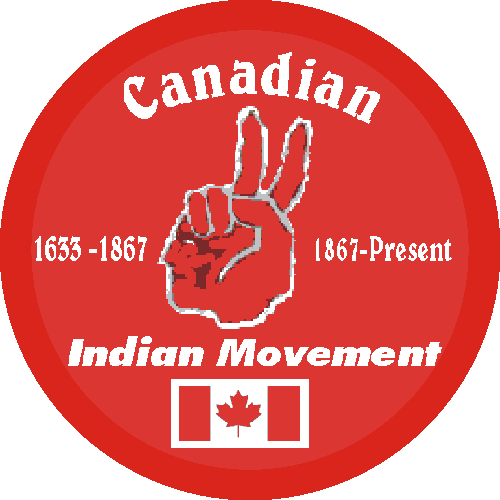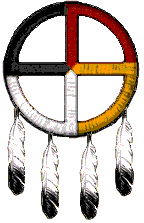


Canadian Indian Movement



| The Canadian
Indian Movement was begun by Pequot Chief Somesomet around 1630, after
the British began to encroach upon traditional Pequot land. It led
to the death of Somesomet and the elimination of the Pequot people
who were either killed or assimilated into other tribes. The next chapter in the movement happened when Chief Alexander died after being invited to a meeting with the British. ( Chief Alexander was the eldest son of Massasoit, the Chief who saved the first pilgrims from starvation when the landed at Plymouth Rock and faced their first winter.) Chief Alexander's death was believed to be murder by the British, so ! His young brother Prince Philip, (Metacomet) joined with two very powerful female tribal chieftains known as the "Squaw Chiefs" and waged a bloody war against the British that lasted several years until 1675 ! The British eventually surprised Prince Phillips and the "Squaw Chiefs" as they slept and killed most of their warriors, they then, drowned both the female chiefs,( Some historians claimed these two females were raped, tortured and weighted down with rocks and thrown into the river) after which they tortured and killed Prince Phillips. To act as a deterrent to other Indians who might resist the British expansion northward, they cut Prince Philip's body into several parts, send these parts to the four corners to the land they occupied, with his head embedded on a pole being displayed at the commons in Boston for two years afterwards.( Since many Indians traded with British and often visited Boston, this was a reminder of the savagery of the British toward anyone who might resist them .) Two months later, a Kennebec Chief, "Squanto" joined up with the great spiritual sage and Chief of the Penobscots. Madockawando, to wage war against the British because two of their soldiers had thrown Squanto's son into the river to drown over a wager that "Indian" children could swim at birth. The reason Madockawando joined Squanto is that the British asked him to trade prisoners, so, Madockawando, as a gesture of good faith, sent his sister to manage the exchange, but the British killed her along witheir Indian prisoners and the warriors who accompanied her . In hopes of keeping the peace, the British invited the Great Warrior Chief Modockawando to sign the second peace and friendship treaty on behalf of all the Wabenaki peoples. This was done in 1678 by Modockawando's brother-in-law Moxus,( Madockawando and Moxus both married daughters of the respected Chief Bomaseen who would sign several treaties in the years that followed .) This treaty was later ratified by Chief Madockawando himself to assure that the British paid him rent for any land they occupied at that time and afterwards..( Madokawando like Prince Phillips was the Grand Chief of the Wabenaki Confederacy, as well as being considered the greatest Spiritual leader of his time ! ) The next event was when the British kidnapped Madockawando's son in law, and he led warriors in a savage war that resulted in such things as the Salem Witch Trials, the Massacres of countless peoples on both sides, the kidnapping of Modockawando's grand-daughter, and the 1693 treaty signed by Madockawando, Moxus and Bomaseen, again, land rents were included. The British continued the war, and this treaty was ratified in 1698 & 99 ( After Madockawando's death in 1698) due to wars encouraged by the French. These wars resulted in murder, assassinations, torture, rapes, kidnappings and other atrocities as one side tried to outdo the others. In 1713, the French had enough, and washed their hands of the affair, leaving the Indians to fare for themselves, by then, the warriors numbered just a few thousand, while the British population had swelled to 3/4 of a million people, and brought their presence into upper Maine and Eastern Canada. In 1723, two other savage events occurred, First, the British captured, tortured and murdered Father Real, the most popular Catholic priest among the Indians, and they then kidnapped Joseph St. Castin, the grandson of Chief Madockawando, so, the Wabenaki Indians entered into yet another round of brutality and savagery toward the British, which resulted in the freeing of St. Castin, and the signing of the 1725-26 Drummer's peace treaty. All, was fairly quit until 1742-43, when the British began plans for a permanent settlement in Nova Scotia, and in 1740, the first settlement was erected in Halifax, war ensued, the 1749 treaty was signed, and plans began for the round-up of all the Indian leaders and their families, who were either killed outright or placed upon ships to be deported. The great deportation began in 1753-55, and over 6000 souls,( * most were mixed breed Indians, including all the main Indian leaders, ) were shipped abroad to the various British colonies, some were killed or imprisoned , while a few escaped to the woods. Some Mi'kmaq bands or tribes remained on their tribal lands, and these small bands engaged the British between 1750 to 1761, after which, with no leadership left, and being outnumbered 1.5 million to 113, they began to sign what the British considered to be surrender treaties. In other parts of Canada, the Hudson Bay Company and the Northwest Company opened the country to colonization, and soon similar wars were carried out from coast to coast with the same results. The Europeans colonized any track of land that they could exploit, the Indians were driven out, and the old ways were lost. The British began the reserves around 1790, these proved the best way to control the remaining indians, leaving assimilation to take care of those who chose not to live on the reserves. So, for the next hundred years, the governments ( Britain until 1867, and the Canadian after 1867) enacted legislation designed to assimilate and civilize the Indian populations from coast to coast, in this time period, few Indian leaders, except maybe Louis Riel, Poundmaker and Black Bear, confronted the governments to any degree. For the next 100 years, there was no real resistance in what is now called Canada, then, in the early 1940's, the Natives began to organize and today, the Indian movement is part of most native communities in Canada and the USA. |
 HOME
HOME